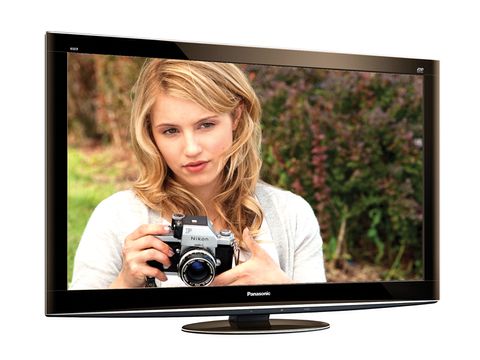Why you can trust TechRadar

You'd think a flagship TV packed with cutting-edge tech would want to shout about its talents with every fibre of its being, but the TX-P46VT20B is rather a dour looking set. It lacks the svelte lines of so many of today's top screens and its sculpting is pretty basic. The best you can say is that the brownish colour scheme is quite unusual and that the set's bodywork feels more robust than most.
The TX-P46VT20B's high-tech innards only start to become apparent with its connections. For instance, all of its four HDMI inputs are built to the v1.4 standard, so they can play full HD 3D from suitable Blu-rays. It's also got a couple of USB ports you can use to play back a wide variety of multimedia file types, or for recording from the TV's digital tuners to certain models of Buffalo JustStore USB hard-disk drives (HDDs), or for inserting the USB Wi-Fi dongle that comes free in the TV's box.
If you don't want to go the Wi-Fi route, there's an Ethernet port for jacking into DLNA PCs or accessing Panasonic's Viera Cast online service. Or, if you're more an SD card kind of person, there's a slot capable of playing photo and music files.
Unusually, the TX-P46VT20B has a satellite LNB input as well as the predictable RF tuner jack. What's more, this LNB input isn't just connected to any old satellite tuner. Rather it feeds a true Freesat HD one, providing a means of receiving neatly packaged HD broadcasts for people – and there are still plenty of them – who currently live outside Freeview HD reception areas.
The Viera Cast online service is best described as fair to middling by today's 'Smart TV' standards. It has a decent amount of 'A-list' content, such as the AceTrax movie rental/purchase platform, Skype, YouTube, Twitter and Eurosport. But there's also a lot of pointless (for most UK residents, anyway) foreign language stuff.
For people more interested in cold, hard picture quality than fancy online TV stuff, the TX-P46VT20B appears to be a very compelling proposition. It's a plasma screen, which means it benefits from the technology's innate advantages in terms of viewing angles, contrast and reduced crosstalk with 3D material. The TX-P46VT20B also builds on all this by adding a special 'Infinite Black Pro' high contrast filter exclusive to the V and VT series and by introducing its proprietary rapid decay 3D technology, for further boosting plasma's already lickety-spit response time.
The panel at the TX-P46VT20B's heart is one of Panasonic's latest NeoPDP offerings, complete with redesigned plasma cells, improved phosphors and a more efficient discharge gas. The panel is driven by Panasonic's '600Hz' sub-field drive technology, too, a system that pulses each cell up to 12 times a second for increased image stability. It's not to be confused with the 100Hz and higher systems employed by LCD TVs to reduce motion blur.
As a flagship model, the TX-P46VT20B additionally benefits from both Panasonic's highest level of video processing (V-Real Pro 5 3D), with additional Intelligent Frame Creation (IFC) interpolation technology for reducing judder.
The TX-P46VT20B makes much more effort to accommodate both professional and serious amateur calibration efforts than previous generations of Panasonic plasmas, a fact that's been rewarded with endorsements from THX and those specialist AV calibration gurus, the Imaging Science Foundation.
Among the fine-tuning tools available are a reasonably full – though not totally comprehensive and poorly presented – colour management system, and various gamma controls.
The THX support has given birth to a THX preset within the various picture modes the TX-P46VT20B carries, and while this preset may feel marginally muted and soft for normal TV viewing, it represents an unusually good 'out of the box' setting for watching Blu-ray movies.
Other bits and bobs of note include brand new Resolution Enhancer circuitry designed to sharpen up standard definition, and a Vivid Colour mode that artificially boosts colour saturations.
Current page: Panasonic TX-P46VT20B: Features
Prev Page Panasonic TX-P46VT20B: Overview Next Page Panasonic TX-P46VT20B: Picture qualityJohn has been writing about home entertainment technology for more than two decades - an especially impressive feat considering he still claims to only be 35 years old (yeah, right). In that time he’s reviewed hundreds if not thousands of TVs, projectors and speakers, and spent frankly far too long sitting by himself in a dark room.


